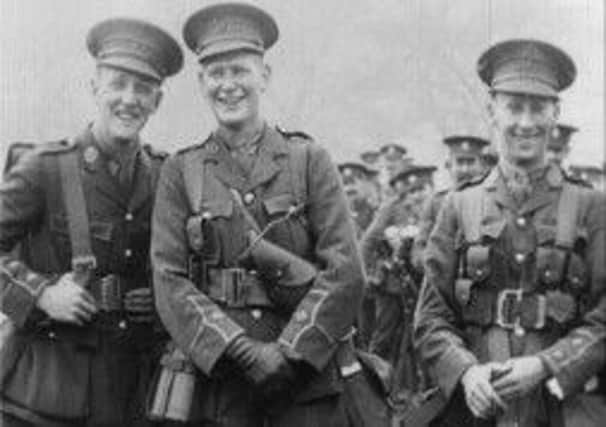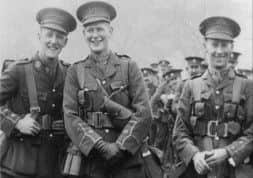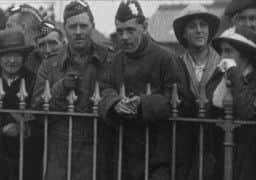Caught on film... men who faced the front line


Many of the faces in the flickering, black and white footage are smiling.
The hair styles and fashions may have changed but apart from that there is seemingly little difference between these young men and those we see on our streets today. There is, of course, one big difference. These films were made a century ago and this youthful nonchalance was soon wiped away as the horrors of the First World War unfolded. Some never returned home alive, while others were swallowed by the soil at places like Ypres, Verdun and the Somme, names that have since become synonymous with bloodshed and slaughter.
Advertisement
Hide AdAdvertisement
Hide AdNext year marks the centenary of the outbreak of a conflict in which millions of lives were lost and one that continues to shape the world in which we live, and numerous activities and events are already underway to commemorate this sombre milestone. Among them is a Yorkshire Film Archive (YFA) project that aims to carry out important preservation work to its First World War film collections and discover some of the stories of those captured in the footage.


Filmed and Not Forgotten, which is being funded by a £52,400 grant from the Heritage Lottery Fund (HLF), will include a series of screenings and talks and culminate in an online exhibition next summer. At present they have around 15 films relating to the war, most just a couple of minutes long, showing footage of Yorkshire soldiers as they prepared to go to war.
These films offer a poignant glimpse into a past world that stood, unknowingly, on the cusp of irrevocable change. Who was the sergeant waving at the camera as he marched over Lendal Bridge in York in 1915, and what happened at the sports day in Scarborough when the regiments stationed there came together with the community for some light relief away from the front line?
Work has already begun to try and identify some of those in the films and the charity is appealing to anyone with information, or who recognises one of the soldiers, to get in touch.
Advertisement
Hide AdAdvertisement
Hide AdArchive assistant Jonty Marr says some of the films come from local military organisations, while others have been sent in by individuals who stumble on them while cleaning out their lofts. “The film of the 1/5th Battalion York and Lancaster Regiment in York came from the regimental museum, but quite often it’s just individuals who find it in a biscuit tin in the attic,” he says.


“They have these films that could potentially just blow up, there was even one guy who was storing a film behind an antique motorbike in his garage. He’d had it for years and it was fine but because a lot of these films are on nitrate film they can be quite volatile, which is why we need to do the preservation work.”
The footage they have paints a fascinating picture of life in Yorkshire at a particular moment in time. “We’ve had some film come in recently of bomb damage in Scarborough from 1918. We’ve also got military racing in Beverley from around 1916 and the Hallamshire battalion marching off to war,” he says.
“Films are an incredibly rare medium through which to look at this particular period and actually they tells us what the world looked like in a more direct and engaging way than we normally get to see.”
Advertisement
Hide AdAdvertisement
Hide AdSue Howard, Yorkshire Film Archive director, says this old footage paints an accurate picture of what life was like. “If you look closely you can see there’s not one good set of teeth between them, but we see a lot of films about World War One these days and they have contemporary actors who are taller and healthier and it’s just not the same.”
We are able to look back with the benefit of hindsight whereas the young men in the films, many of who had eagerly signed up, had little idea of the fate that awaited them. “There’s a really touching moment where a woman grabs hold of her sweetheart’s hand as they go over the bridge [in York] and it pulls at your heart-strings, because you can’t help but wonder what happened to him. Which is the whole point of this project, to find out more about some of the people in these films. Some of these men won’t have survived the war but others will have done.”
Between them the films span the length of the war and Marr says that as news of the horrors of life in the trenches, and the sheer scale of the casualties, became evident to people back home the films take on a more sombre tone.
“Nobody had any idea what was about to happen so it’s really interesting when you start to go through the films, because at the beginning they’re all quite jingoistic. But that obviously changes as the war goes on. You see the mood change and we have a film from 1916 in Hull which was a call for money to help those who’d been injured on the front.”
Advertisement
Hide AdAdvertisement
Hide AdHoward says a big emphasis is on tracing some of the families and finding out what happened to their relatives. “Was your grandfather, or great-grandfather, stationed in Ripon around this time? We want to hear about those personal stories and then we can set them against the context of what was happening at the Front.”
They’re also keen to trace any more films that may exist. “We’ve been sent some film footage which we think shows some bomb damage in Scarborough, because the town was attacked from the sea. There could well still be material out there but primarily our work is focused on the collections that we know about. It’s a small collection but it’s really significant,” she says.
“Film was just coming into its own around this time as a form of communication, it hadn’t been there before. There are small amounts of film from the Boer War but the First World War was the first major conflict to be documented on film.”
The fact that the footage they have comes from all over Yorkshire shows what a huge impact the war had. “If you think about places like Ripon and Scarborough and the links those two places had with someone like Wilfred Owen.
Advertisement
Hide AdAdvertisement
Hide Ad“He wrote some of his most famous works when he was in Ripon and he also spent time in Scarborough. He was stationed in Ripon for three or four months when he returned to the UK on sick leave and that’s where he wrote poems like The Send-off when he was there.”
During the war around 350,000 troops were based at Ripon at one time or another before they headed to France, which gives an idea of the scale of the conflict. “If you think about the kind of impact this had on the local community it was absolutely massive and it would have been a similar story in places all over the country.”
There is growing interest in the war as next year’s anniversary approaches and Howard says the number of requests for information or pictures from the war is increasing by the week. “It’s a hundred years on so this is a really significant landmark. It really is and I think we’ll see that through all the activities and events building up over the coming months.”
August 1914 was the month when the lamps went out all over Europe, as the then Foreign Secretary Sir Edward Grey famously said, and nearly a century on the First World War still resonates with people.
Advertisement
Hide AdAdvertisement
Hide Ad“It doesn’t matter what town or city you’re in, or what village you’re in, there is that memorial to the people who fell during the war. It had a massive affect on every single community and people do want to document what happened and they want to stop and remember.”
• For more information about the Filmed and Not Forgotten project, visit www.yorkshirefilmarchive.com